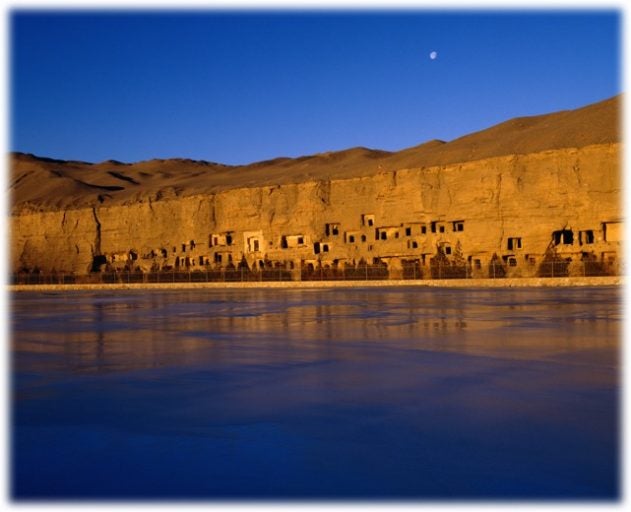Lanlan Kuang’s research this summer is mixing the old with the new. And by “old,” we mean ancient.
Kuang is a UCF assistant professor of philosophy and one of a select group of international scholars with access to the Dunhuang Mogao Caves along the Silk Road in China. The nearly 500 caves are the largest and most complete treasure repository of Buddhist art, murals and more than 2,000 painted sculptures.
The researcher is fascinated by the dance, music, poetry, painting and ideas exchanged all along the Silk Road, the more than 2,000-year-old network of trade routes that stretched from eastern China to the Mediterranean Sea. So this summer, Kuang – who was acknowledged earlier this year as an expert on Silk Road arts by China’s Xinhua News Agency – is researching and digitally preserving the expressive arts along the route in northwest China.
This month and next she is conducting fieldwork at the caves, a protected UNESCO World Heritage site carved into the cliffs above the Dachuan River in the Gobi Desert.
The historic site began in 366 and features Buddhist works created until the 14th century. The artworks depict politics, economics, religion, culture and attire of western China, and combine Chinese style with Indian, Turkish, Tibetan and other traditions.
The general public can only enter a handful of the Mogao Caves and cannot take photos. Kuang is one of the selected scholars to have access to the restricted areas and the Dunhuang Research Academy. She has been working with the academy’s Network and Information Center on a book that traces the history of the organization’s data collection, storage, exchange and display of both movable and immovable cultural relics.
Before arriving at the caves, Kuang started her summer-long trip in Chongqing, the birthplace of spicy hot pot, to research the food heritage of China. The final leg of her trip will be to China’s porcelain capital, Jingdezhen, to interview scholars for a research project on sustainability, environmental policy and China’s porcelain culture.
“Along with silk and tea, China’s porcelain is another key exported item connecting the East and the West through the Maritime Silk Road,” Kuang said. “In fact, porcelain is so identified with China that it is still called ‘china’ in everyday English usage.”
Kuang has visited China frequently, including a year hosted by Lanzhou University as a Fulbright scholar. She has a Ph.D. in folklore and ethnomusicology from Indiana University, Bloomington, and came to UCF in 2012. As an ethnomusicologist she studies music in a sociocultural context. She also has worked with the U.S. Information Agency.
“This is the first time I return to the Gobi as a UCF faculty, which makes the trip especially exciting,” she said. “In addition to adding data for my own research publication, I now have the opportunity to share my fieldwork experience with my wonderful students.”
Kuang said there has been increased research interest recently on the Silk Road. The Getty Institute in Los Angeles held a special Silk Road Buddhist Art exhibition last fall and the University of California, Berkeley, established a new Silk Road Research Center earlier this year.
Following her trip to China, Kuang has several dates scheduled at conferences around the world to present her findings on sustainable heritage conservation, education and cultural tourism. Her travels will take her to Spain in July, Portugal in September, Denver and Minneapolis in October, and then home at UCF in November as a presenter for the 2017 national conference of HASTAC (Humanities, Arts, Science, and Technology Alliance and Collaboratory).
“Her work is significant because she’s showing the connection between the very old cultural system reflected in the grottoes in Dunhuang and contemporary performing art forms,” said UCF philosophy Professor Bruce Janz, co-director of UCF’s Center for Humanities and Digital Research and organizer of the HASTAC conference. “She is, in effect, showing a version of China to the world that is much more complex and rich than what we often get.
“She is showing how contemporary performance preserves ancient traditions, while not simply reproducing them in a simplistic manner. Dunhuang is an important stop on the Silk Road, and so by definition this is about cultural exchange, both ancient and modern.”
Kuang said she gears much of her research based on what American folklorist Henry Glassie said about the past: “It’s important to look at the overlooked, look for what was left out of the records.”
Another one of her goals this trip is to explore collaborative opportunities for UCF and several research institutes in China, which helps expand UCF’s global impact by joining the international scholarly community.
“Folk arts and cultural heritage serve as bridges between generations and peoples, which are of increasing importance today in a globalized world where interconnections and diversity must serve as opportunities to build peace in the minds of men and women,” Kuang said.
